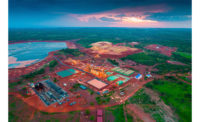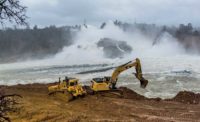U.S. dam safety frameworks have helped to prevent major calamities, but the May collapse of the 95-year-old Edenville Dam in Michigan illustrates that key failure risks remain—often involving many causes, according to a study of dam safety risk assessments by Oak Ridge National Laboratory.
“It’s really unusual that a big system fails because of one thing,” says Greg Baecher, professor of civil and environmental engineering at the University of Maryland, and co-author of the Oak Ridge report conducted for the U.S. Nuclear Regulatory Commission and published late last year.
Normally, he says, a series of flaws “that align in a malicious combination” cause a failure.
Lewis E. "Ed" Link, a research professor in the university's Dept. of Civil and Environmental Engineering, agrees: “If you look at the statistics of dam failures, there's a pretty large chunk of them due to a cascading failure of components, not necessarily extreme water conditions.” Link was named ENR Award of Excellence winner in 2005 for analyzing the failure of the southeast Louisiana flood protection system after Hurricane Katrina.
Most often, dams fail due to a series of flaws “that align in a malicious combination.”
– Greg Baecher, professor of civil and environmental engineering, University of Maryland
The experts point to the February 2017 failure of the Oroville Dam in California as a good example of weaknesses in the standard approach to risk analysis. Its spillway failed despite federal regulation, frequent inspection and location in a state with a strong regulatory program.
The U.S. Army Corps of Engineers’ National Inventory of Dams lists more than 90,000 U.S. structures, of which more than 15,500 are considered high hazard. For a dam to be classified as high hazard, its “failure or mis-operation is likely to cause at least one human life loss,” according to the inventory.
The definition itself is problematic, says Baecher. “If I build a dam out in the middle of nowhere and someone then builds a house downstream, the dam suddenly goes from low hazard to a high hazard," he contends. "Nothing's changed in the hydrology. Nothing's changed in the dam, just some person moved in downstream."
Dam hazard should be based on risk, says Baecher, which should be looked at as the probability of a serious failure happening, multiplied by the consequences. “That’s the standard definition of risk," says the researcher.
The hazard definition is indicatIve of the standards-based approach used in much of existing dam safety risk assessment, the experts say.
A standards-based approach focuses on the physical structure of the dam and takes relatively few conditions into account. The Federal Energy Regulatory Commission recommends that the evaluation instead relies on a risk-informed decision making approach. This uses probabilistic risk assessment to focus on sequences of possible events, characterizing the likelihood and consequences of each scenario.
The Federal Emergency Management Agency issues guidelines, but standards are set by states. All have a dam safety agency, except for Alabama.
Funding has been a perennial issue for states. According to a 2019 Association of State Dam Safety Officials estimate, the gap between funding and need to habilitate non-federal dams is nearly $66 billion. More than 64% of dams are privately owned, exacerbating the problem, since many private owners have difficulty funding maintenance and repairs.
Improvements have been made in development of Emergency Action Plans, which the American Society of Civil Engineers considers vital for mitigating risk in the event of a high-hazard dam failure. According to the dam safety officials' group, the percentage of high hazard dams with such plans increased from 35% to 81% between 1999 and 2018, although seven states report that fewer than 70% of high-hazard dams have one.
Closing that last gap will likely require legislative-changes. “Some states still don’t have legislative or statutory authority to require an emergency action plan, though that number has definitely diminished over the years,” says Mark Ogden, a dam safety group project manager.
Shifting Approaches
Taking a broad approach to risk assessment is especially important as variables rapidly change, says Link. Global warming is driving change in weather patterns, but other factors are also in flux, adding significant complexity to risk models.
“The land use has changed dramatically,” explains Link. Even if weather patterns weren’t different due to climate change, flooding would not be the same because the water system in the area of the dam is altered, he adds, with "urbanization on top of that.”
Use of a scenario analysis rather than a historically based standards approach could counter the effect of changing conditions, Link says, and having a national, uniform policy for risk evaluation and assessment would help improve effectiveness in anticipating, imagining and dealing with unanticipated hazards such as dam failures.
Link compares the issue to COVID-19. “We have 50 states with different approaches to dealing with the pandemic largely because we have no federal uniform approach. We’re not doing very well with COVID,” he says.
The Edenville Dam event illustrates the multiple factors that build up to a failure. In addition to the dam's age and budget constraints, operators faced a disconnect between state and federal authorities. As an energy producing dam, FERC required Edenville spillways to handle 100% of the probable maximum flood. When the dam was only able to meet 50% of the maximum flood, the agency revoked its license.
Operators could not recoup the cost of a fix from potential added generation. However, the state of Michigan only requires spillways to meet 50% of the maximum flood, so the dam remained in service and was not required to lower its water level because it met state licensing rules.
“You can’t predict what’s going to happen in 2050 or 2100, but you can surmise what the different scenarios are," says Link. "Then you find out how well your current approaches would deal with these very different scenarios. You get a broad spectrum of possible conditions in the future and it stretches your thinking,”
Link cites work done in the Netherlands as a model for long-term risk analysis.
“The Dutch have an incremental, adaptive strategy with multiple steps for dealing with different types of crises they may face in the future,” he says. Experts there ran scenarios using radical differences in sea-level rise, land use patterns and in social and cultural needs. The scenarios may never actually happen, but “they tell you when you’ve got to change." Link explains.
"When you get to a meter of sea-level rise, you have to have a different set of tools in place." he says. "When you get to two meters, you’d better have another. You have to have a Plan B in place that adds to Plan A. The Dutch now have plans for doing that.”






Post a comment to this article
Report Abusive Comment